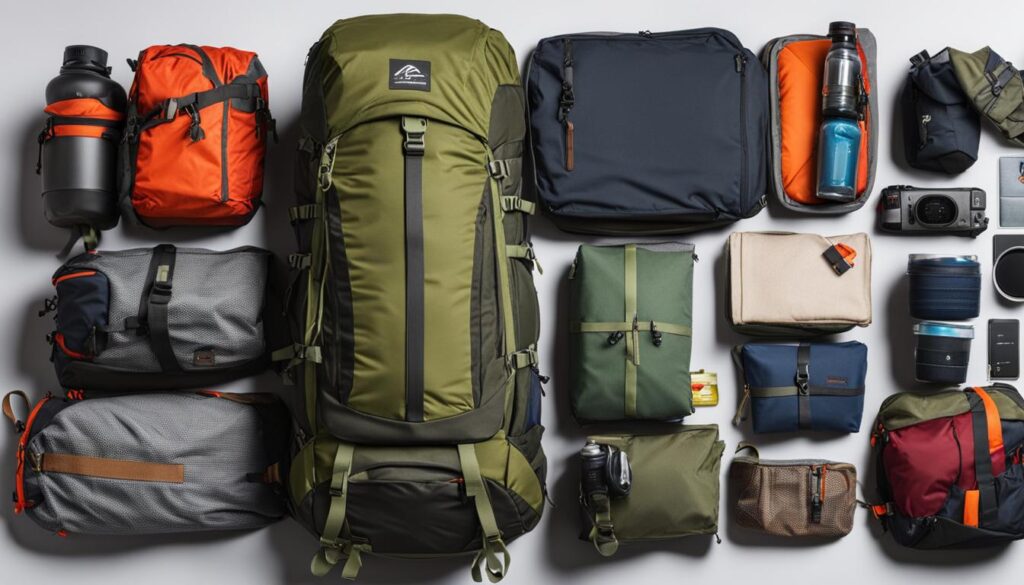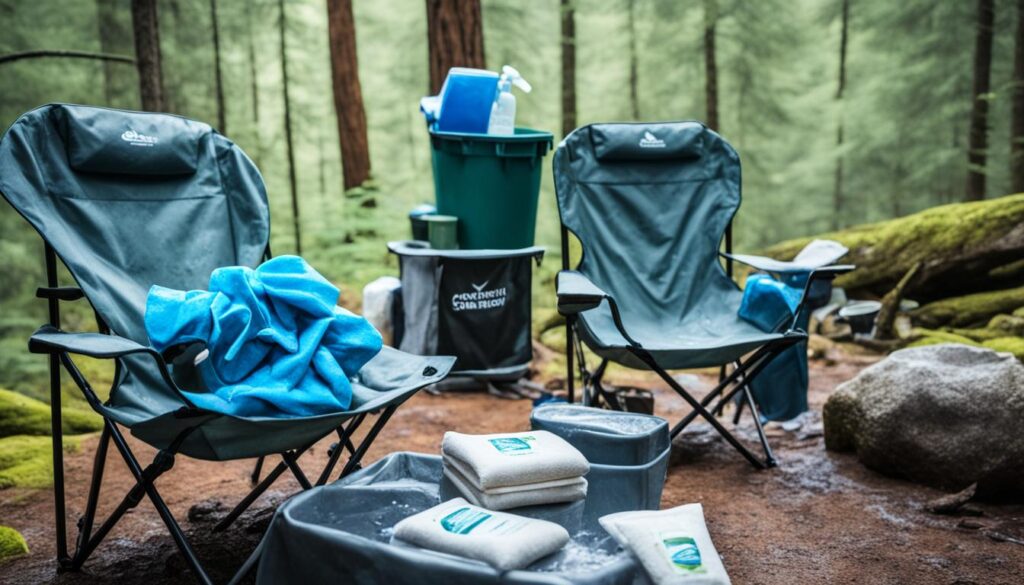Properly packing a backpack for camping is essential for a comfortable and convenient outdoor adventure. By following these expert tips, you’ll learn how to efficiently pack your backpack and ensure that you have all the necessary camping essentials within easy reach.
Key Takeaways
- Choose the right backpack size and fit for your camping trips.
- Organize your gear based on weight distribution for a balanced pack.
- Utilize compression sacks and various pockets for efficient backpack organization.
- Waterproof your pack to protect your camping essentials from rain.
Contents
Choosing the Right Backpack
When it comes to backpacking, selecting the right backpack is crucial for a successful and comfortable outdoor adventure. Properly packing your backpack starts with choosing the appropriate size and fit. In this section, I’ll provide you with some essential backpack packing tips to help you find the perfect backpack for your needs.
Volume and Capacity
The volume of your backpack is one of the key considerations when it comes to packing efficiently. You want a pack that is large enough to hold all your backpacking essentials, but not excessively big, causing you to carry unnecessary weight. Aim for a backpack with a capacity of 40-70 liters, depending on the length and type of your camping trips. If you’re planning a short weekend getaway, a smaller pack will suffice, while longer trips may require a larger backpack.
Proper Fit
Choosing a backpack that fits you well is essential to ensure your comfort during your outdoor adventures. Ill-fitting backpacks can cause discomfort, pain, and even injuries. To find the right fit, I recommend visiting an outdoor store and trying on different backpacks. Adjust the straps, hip belt, and shoulder harness to achieve a balanced load and a snug fit. Alternatively, you can measure your back length at home to determine the right backpack size for you.
“Properly packing your backpack starts with choosing the appropriate size and fit.”
Remember, a properly fitting backpack should distribute the weight evenly across your hips and shoulders, with no pressure points or excessive strain on any specific area of your body.
Additional Considerations
Aside from volume and fit, there are other factors to consider when selecting a backpack. Look for a backpack with adjustable suspension, allowing you to customize the fit based on your body type and preferences. Consider the number and accessibility of pockets and compartments, as well as the quality and durability of the materials used in the backpack’s construction. It’s also worth checking if the backpack comes with a rain cover or if you need to purchase one separately to protect your gear from wet weather conditions.
Choosing the right backpack is the foundation of successful backpacking. By following these backpack packing tips and assessing the volume, fit, and additional features of the backpack, you’ll be well-equipped for your outdoor adventures.
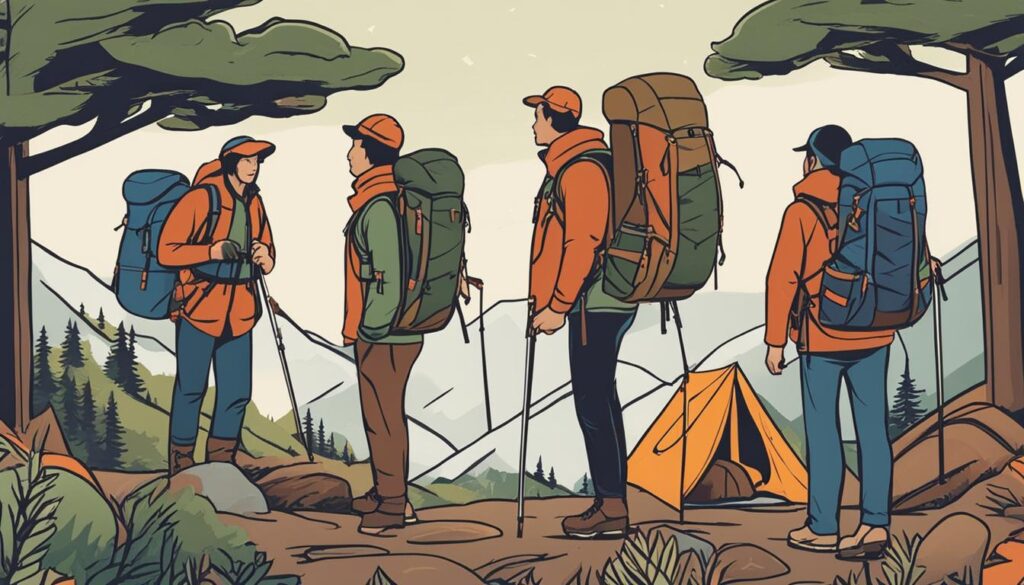
| Backpack Features | Things to Consider |
|---|---|
| Volume | Ensure your backpack has enough capacity to hold all your gear without being too large and heavy. |
| Fit | Try on different backpacks and adjust the straps and harness to find the perfect fit for your body. |
| Adjustable Suspension | Look for a backpack with adjustable suspension to customize the fit and comfort. |
| Pockets and Compartments | Consider the number and accessibility of pockets and compartments for organizing your gear efficiently. |
| Materials and Durability | Choose a backpack made of high-quality materials that can withstand the rigors of backpacking. |
| Rain Cover | Determine if the backpack comes with a rain cover or if you need to purchase one separately. |
Organizing Your Gear
Before you embark on your camping adventure, it’s important to pack your backpack efficiently and ensure that all your gear is organized. Follow these tips to make the most of your backpack space and keep your camping essentials easily accessible.
Use a Camping Packing Checklist
Start by creating a comprehensive camping packing checklist to ensure that you have all the necessary gear for your trip. A checklist helps you stay organized and ensures that you don’t forget any important items. Here’s a sample checklist to get you started:
- Tent and sleeping bag
- Cooking gear and utensils
- Food and water
- Clothing and footwear
- First aid kit
- Lighting equipment
- Toiletries and personal items
- Navigation tools
- Emergency supplies
Check off each item as you pack it to ensure nothing is left behind.
Distribute Weight Strategically
When packing your backpack, it’s important to distribute the weight effectively. Place heavier items, such as your sleeping bag and cooking gear, in the middle back of your pack. This helps maintain a stable center of gravity and prevents your backpack from feeling lopsided. Furthermore, packing heavier items closer to your back also improves your overall balance and stability while hiking.
Use the bottom of your pack for bulkier items like your sleeping pad. This not only provides cushioning for your back but also helps balance the weight distribution. Pack lighter items, such as clothing and smaller gear, in the front and top of your pack for easy access and to prevent larger items from shifting. This organization allows you to easily reach the essentials you need throughout your camping trip.
Maximize Backpack Space
To make the most of your backpack space, consider using compression sacks. These handy tools allow you to compress your clothing and other soft items, maximizing space and making it easier to fit everything in your backpack. Compression sacks also help keep your gear organized and separate different types of items.
Additionally, take advantage of the various pockets and compartments of your backpack. Store smaller essentials like snacks, a water filter, or a first aid kit in these compartments to keep them easily accessible. Utilize tool loops and lash-on points on the exterior of your pack for attaching larger items such as trekking poles or a tent.
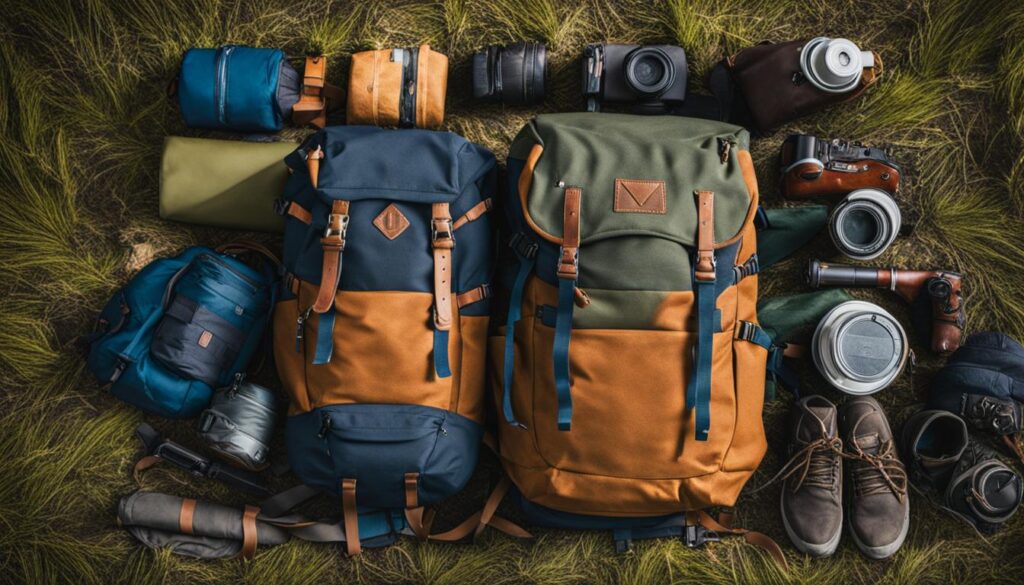
By following these tips for organizing your gear, you’ll be able to pack your backpack efficiently and have quick access to your camping essentials when needed. Stay tuned for the next section, where we’ll discuss additional packing strategies and tips to ensure a successful camping adventure.
| Item | Quantity |
|---|---|
| Tent | 1 |
| Sleeping bag | 1 |
| Cooking stove | 1 |
| Cooking utensils | 1 set |
| Food | 3 days’ worth |
| Water | 3 liters |
| Clothing | 1 set per day |
| Hiking boots | 1 pair |
| First aid kit | 1 |
| Headlamp | 1 |
| Toiletries | 1 set |
| Map and compass | 1 each |
| Emergency blanket | 1 |
Packing Strategies and Tips
When it comes to backpacking, efficient packing is key. By using smart organization techniques and taking advantage of storage options, you can maximize space and ensure easy access to your backpacking essentials. Follow these tips to pack your backpack like a pro.
Compression Sacks to Maximize Space
One of the best ways to optimize the space in your backpack is by using compression sacks. These handy bags allow you to compress bulky items such as sleeping bags and clothing, removing excess air and creating more room in your pack. Pack your gear tightly in the sacks and zip them up to condense the contents, making it easier to fit everything in your backpack.
Utilize Pockets and Compartments
Your backpack likely has multiple pockets and compartments designed to help you stay organized. Take advantage of these storage options to keep smaller essentials easily accessible. Use the front and top compartments for items you’ll need frequently, such as snacks, a water filter, or a first aid kit. Place these items in ziplock bags or small containers to prevent them from getting lost or damaged.
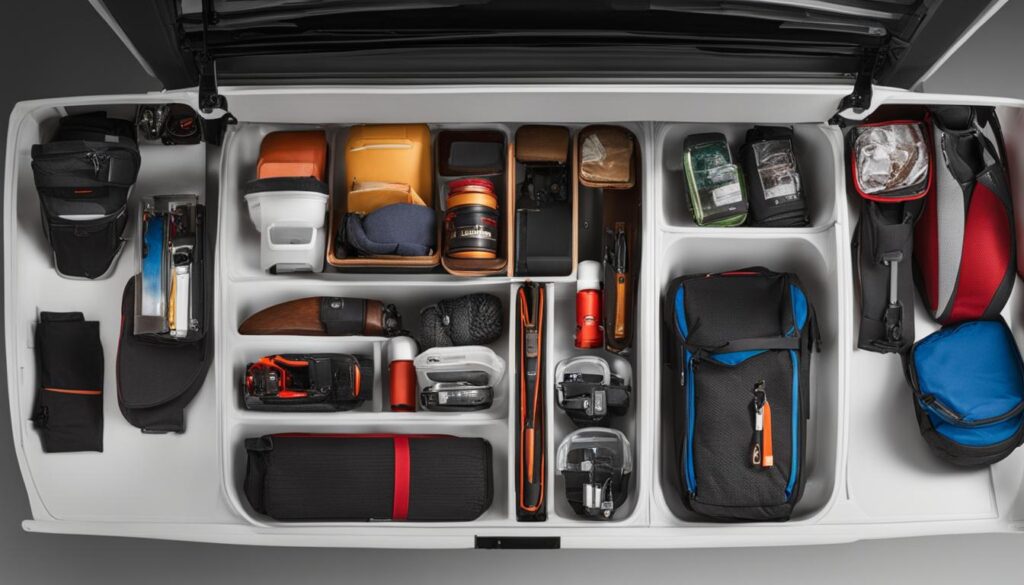
Attach Larger Items with Tool Loops and Lash-On Points
To free up space inside your backpack, consider attaching larger items like trekking poles or a tent to the external loops and lash-on points. This not only maximizes the storage capacity of your pack but also keeps certain items easily accessible for quick setup or adjustments. Make sure to secure these items properly to prevent them from coming loose during your hike.
“Packing your backpack efficiently is crucial for a successful and enjoyable backpacking trip. By utilizing compression sacks, utilizing pockets and compartments, and securing larger items with tool loops and lash-on points, you’ll be able to access your essentials easily and make the most of the limited space in your pack.”
| Benefits of Compression Sacks | Benefits of Pockets and Compartments | Benefits of Tool Loops and Lash-On Points |
|---|---|---|
| – Maximizes space in your backpack | – Provides easy access to smaller essentials | – Frees up space inside your pack |
| – Helps organize and compress bulky items | – Prevents loss or damage of small items | – Keeps larger items easily accessible |
| – Reduces the overall weight of your pack | – Allows for efficient packing and unpacking | – Ensures stability and balance during your hike |
Waterproofing Your Pack
When venturing into the great outdoors, it’s crucial to be prepared for unexpected rain showers. One of the most important steps in protecting your camping essentials and backpacking gear is waterproofing your pack. By taking a few simple precautions, you can ensure that everything inside your pack stays dry and ready to use.
To start, consider using a waterproof backpack cover specifically designed to protect your gear from rain. These covers are usually made from durable materials and feature elastic edges to secure them tightly around your pack. Alternatively, you can line the inside of your pack with heavy-duty plastic bags to provide an additional layer of protection.
As you pack your backpack, make sure to pay attention to the zippers and compartments. Ensure they are properly closed and sealed to prevent any water from seeping inside. Take your time to double-check that all openings are tightly shut, safeguarding your gear from any potential moisture.
By waterproofing your pack, you can have peace of mind knowing that your camping essentials and backpacking gear will stay dry, regardless of the weather conditions you encounter. Whether you’re trekking through rain-soaked trails or setting up camp in a drizzle, your waterproofed pack will keep your items safe and ready for use whenever you need them.
FAQ
How do I choose the right backpack for camping?
When choosing a backpack for camping, consider the volume and fit. Look for a pack with a capacity of 40-70 liters, depending on the length and type of your camping trips. Ensure the backpack fits you properly by visiting an outdoor store or measuring your back length.
How should I organize my gear in my backpack?
When organizing your gear, distribute the weight evenly in your pack. Place the heaviest items, like your sleeping bag and cooking gear, in the middle back of your pack. Use the bottom for bulky items such as your sleeping pad, and pack lighter items like clothing in the front and top for easy access.
Are there any packing strategies to maximize space and organization?
Yes, consider using compression sacks to maximize space and keep your gear organized. Compression sacks remove excess air and make it easier to fit everything in your pack. Take advantage of the various pockets and compartments in your backpack for storing smaller essentials, and use tool loops and lash-on points for attaching larger items.
How do I protect my gear from rain?
To protect your gear from rain, use a waterproof backpack cover or line the inside of your pack with heavy-duty plastic bags. Ensure the zippers and compartments of your pack are properly closed and sealed to prevent water from seeping in. This will keep your camping essentials dry during unexpected rain showers.
